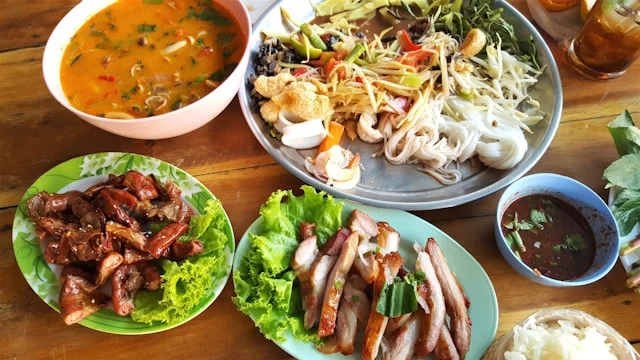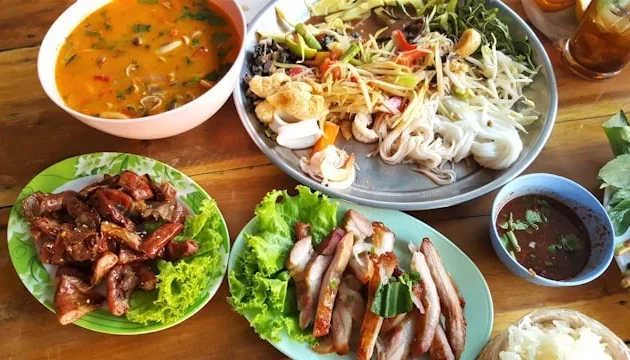
Embarking on a culinary journey through Thai cuisine is akin to traversing a rich cultural tapestry woven with intricate flavors, vibrant colors, and aromatic spices. Thai food is celebrated globally for its harmony of flavors, balancing sweet, salty, sour, and spicy elements in each dish. This gastronomic adventure not only tantalizes the taste buds but also offers a glimpse into Thailand’s rich heritage and traditions.
The Essence of Thai Cuisine
Thai cuisine is deeply rooted in the country’s history and geography, with influences from neighboring countries like China, India, and Malaysia. The essence of Thai food lies in its ability to combine multiple tastes in one dish, creating a complex yet harmonious flavor profile. The key ingredients include fresh herbs such as lemongrass, kaffir lime leaves, galangal, and Thai basil, along with staple items like fish sauce, shrimp paste, and coconut milk.
Regional Variations
Thailand’s diverse regions each contribute unique elements to its cuisine, resulting in a wide array of regional dishes that are distinct yet interconnected.
Central Thailand
Central Thai cuisine is characterized by its use of fragrant jasmine rice, coconut milk, and a balance of sweet and savory flavors. Famous dishes from this region include Pad Thai, a stir-fried noodle dish, and Tom Yum Goong, a hot and sour shrimp soup. The influence of royal cuisine is evident in the meticulous preparation and presentation of dishes.
Northern Thailand
Northern Thai cuisine, also known as Lanna cuisine, features hearty and flavorful dishes that reflect the cooler climate and mountainous terrain. Sticky rice is a staple here, and popular dishes include Khao Soi, a coconut curry noodle soup, and Sai Ua, a spicy sausage made with herbs and spices.
Northeastern Thailand (Isaan)
Isaan cuisine is known for its bold flavors, often incorporating fermented fish and pungent herbs. The region’s signature dishes include Som Tum, a spicy green papaya salad, and Larb, a minced meat salad seasoned with lime juice, fish sauce, and roasted rice powder. Sticky rice is also a mainstay in Isaan meals.
Southern Thailand
Southern Thai cuisine is distinguished by its spiciness and liberal use of coconut milk and turmeric. The coastal region’s bounty of seafood is showcased in dishes like Gaeng Som, a sour curry with fish, and Tom Kha Gai, a coconut soup with chicken and galangal. The region’s Muslim population also influences the cuisine, evident in dishes like Massaman Curry.
Staple Ingredients and Flavors
Thai cuisine’s complexity and depth are attributed to its fresh ingredients and skillful use of spices. Some of the most essential ingredients include:
- Lemongrass: Adds a citrusy aroma and flavor.
- Kaffir Lime Leaves: Impart a distinct fragrance.
- Galangal: A relative of ginger with a sharp, peppery taste.
- Thai Basil: Offers a sweet, anise-like flavor.
- Fish Sauce: Provides a salty, umami flavor.
- Shrimp Paste: Adds depth and a slightly fermented taste.
- Coconut Milk: Contributes richness and creaminess.

Balancing the Flavors
The hallmark of Thai cuisine is its delicate balance of flavors. Chefs strive to achieve the perfect blend of sweet, sour, salty, and spicy in each dish. For example, the sweetness of coconut milk balances the heat of chili peppers, while lime juice adds a tangy contrast to the savory fish sauce.
Signature Thai Dishes
Exploring Thai cuisine is incomplete without savoring its signature dishes, each showcasing the country’s culinary artistry.
Pad Thai
A ubiquitous street food favorite, Pad Thai features stir-fried rice noodles with eggs, tofu, shrimp, and bean sprouts, all tossed in a tangy sauce made from tamarind paste, fish sauce, and palm sugar. It’s garnished with crushed peanuts and lime wedges, offering a burst of flavors and textures in every bite.
Tom Yum Goong
This iconic soup is a harmonious blend of spicy, sour, and savory flavors. Tom Yum Goong combines shrimp, mushrooms, lemongrass, kaffir lime leaves, galangal, and chili peppers in a broth seasoned with fish sauce and lime juice. It’s often garnished with fresh cilantro, enhancing its aromatic appeal.
Green Curry (Gaeng Keow Wan)
Green Curry is a creamy and spicy dish made with green curry paste, coconut milk, and a variety of vegetables and proteins such as chicken or tofu. The paste is crafted from green chilies, lemongrass, kaffir lime leaves, and shrimp paste, resulting in a vibrant and aromatic curry that’s both rich and flavorful.
Massaman Curry
A milder, yet equally delicious curry, Massaman Curry has Persian and Indian influences. It’s made with a rich paste of roasted spices, including cinnamon, cardamom, and cloves, combined with coconut milk, potatoes, peanuts, and tender meat, usually beef or chicken. This dish epitomizes the complexity and diversity of Thai cuisine.
Som Tum
Som Tum, or spicy green papaya salad, is a quintessential Isaan dish. It combines shredded unripe papaya with tomatoes, green beans, peanuts, and chili peppers, all pounded together with a dressing of lime juice, fish sauce, and palm sugar. The result is a refreshing yet fiery salad that awakens the palate.
The Art of Thai Cooking
Thai cooking is an art form that requires not only the right ingredients but also precise techniques. Key methods include:
- Stir-frying: A high-heat method used to quickly cook ingredients while retaining their flavor and texture.
- Simmering: Gently cooking ingredients in liquid to infuse flavors, as seen in soups and curries.
- Grilling: Commonly used for meats and seafood, imparting a smoky flavor.
- Pounding: Using a mortar and pestle to blend herbs and spices, creating pastes that are the backbone of many dishes.
The Role of Street Food
Thai street food is an integral part of the culinary landscape, offering a diverse array of dishes that are quick, affordable, and delicious. Vendors can be found on every corner, serving up everything from skewered meats and grilled seafood to sweet treats like Mango Sticky Rice. This vibrant street food culture allows both locals and visitors to experience authentic Thai flavors in a casual setting.
Cultural Significance
Thai cuisine is deeply intertwined with the country’s culture and traditions. Meals are often communal, reflecting the importance of family and community. Festivals and celebrations feature elaborate feasts, showcasing the diversity and richness of Thai food. Additionally, the meticulous presentation of dishes highlights the Thai appreciation for aesthetics and balance.